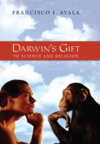 We congratulate National Academy of Sciences member Francisco J. Ayala for winning the 2010 Templeton Prize. Dr. Ayala is an evolutionary geneticist and molecular biologist who has vigorously opposed the entanglement of science and religion while also calling for mutual respect between the two. The Prize, announced at a news conference at the National Academy of Sciences in Washington, DC, honors a living person who has made exceptional contributions to affirming life’s spiritual dimension.
We congratulate National Academy of Sciences member Francisco J. Ayala for winning the 2010 Templeton Prize. Dr. Ayala is an evolutionary geneticist and molecular biologist who has vigorously opposed the entanglement of science and religion while also calling for mutual respect between the two. The Prize, announced at a news conference at the National Academy of Sciences in Washington, DC, honors a living person who has made exceptional contributions to affirming life’s spiritual dimension.
In nominating Ayala for the Prize, Dr. Ralph J. Cicerone, president of the National Academy of Sciences, recounted the broad influence of Ayala’s scientific teaching and writings, including more than 1,000 papers and 35 books, adding, “A pervasive message of several of these publications is that science is a way of knowing, but it is not the only way. The significance and purpose of the world and human life, as well as matters concerning moral or religious values, transcend science.”
Ayala was asked by the National Academy of Sciences to serve as committee chair of a landmark booklet updated several times called Science, Evolution, and Creationism. He also wrote Darwin’s Gift to Science and Religion (Joseph Henry Press), a broad review of the proper context of science and religion in modern society.
For more information, read the press release here.
Featured Publications
Science, Evolution, and Creationism
How did life evolve on Earth? The answer to this question can help us understand our past and prepare for our future. Although evolution provides credible and reliable answers, polls show that many people turn away from science, seeking other explanations with which they are more comfortable.
In the book Science, Evolution, and Creationism, a group of experts assembled by the National Academy of Sciences and the Institute of Medicine explain the fundamental methods of science, document the overwhelming evidence in support of biological evolution, and evaluate the alternative perspectives offered by advocates of various kinds of creationism, including “intelligent design.” The book explores the many fascinating inquiries being pursued that put the science of evolution to work in preventing and treating human disease, developing new agricultural products, and fostering industrial innovations. The book also presents the scientific and legal reasons for not teaching creationist ideas in public school science classes.
Mindful of school board battles and recent court decisions, Science, Evolution, and Creationism shows that science and religion should be viewed as different ways of understanding the world rather than as frameworks that are in conflict with each other and that the evidence for evolution can be fully compatible with religious faith. For educators, students, teachers, community leaders, legislators, policy makers, and parents who seek to understand the basis of evolutionary science, this publication will be an essential resource.
Darwin’s Gift to Science and Religion (Joseph Henry Press)
 With the publication in 1859 of On the Origin of Species by Means of Natural Selection, Charles Darwin established evolution by common descent as the dominant scientific explanation for nature’s diversity. This was to be his gift to science and society at last, we had an explanation for how life came to be on Earth.
With the publication in 1859 of On the Origin of Species by Means of Natural Selection, Charles Darwin established evolution by common descent as the dominant scientific explanation for nature’s diversity. This was to be his gift to science and society at last, we had an explanation for how life came to be on Earth.
Scientists agree that the evolutionary origin of animals and plants is a scientific conclusion beyond reasonable doubt. They place it beside such established concepts as the roundness of the earth, its revolution around the sun, and the molecular composition of matter. That evolution has occurred, in other words, is a fact.
Yet as we approach the bicentennial celebration of Darwin’s birth, the world finds itself divided over the truth of evolutionary theory. Consistently endorsed as good science by experts and overwhelmingly accepted as fact by the scientific community, it is not always accepted by the public and our schools continue to be battlegrounds for this conflict. From the Tennessee trial of a biology teacher who dared to teach Darwin’s theory to his students in 1925 to Tammy Kitzmiller’s 2005 battle to keep intelligent design out of the Dover district schools in Pennsylvania, it’s clear that we need to cut through the propaganda to quell the cacophony of raging debate.
With the publication of Darwin’s Gift, a voice at once fresh and familiar brings a rational, measured perspective to the science of evolution. An acclaimed evolutionary biologist with a background in theology, Francisco Ayala offers clear explanations of the science, reviews the history that led us to ratify Darwin’s theories, and ultimately provides a clear path for a confused and conflicted public.












